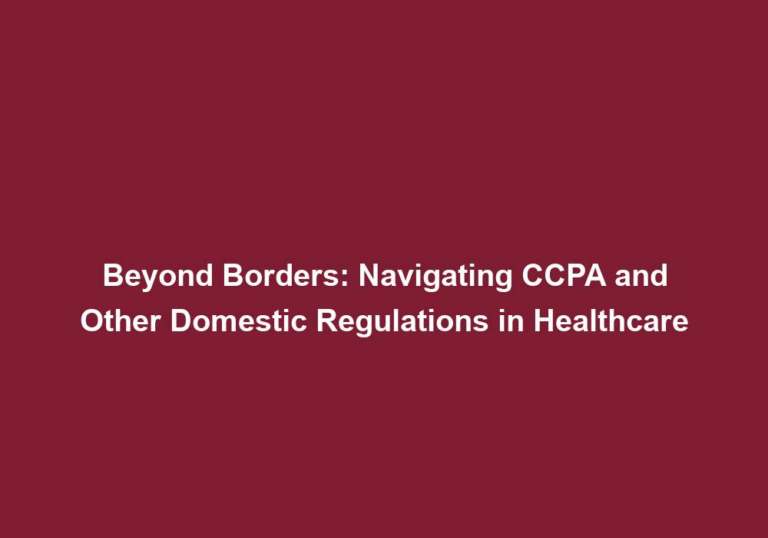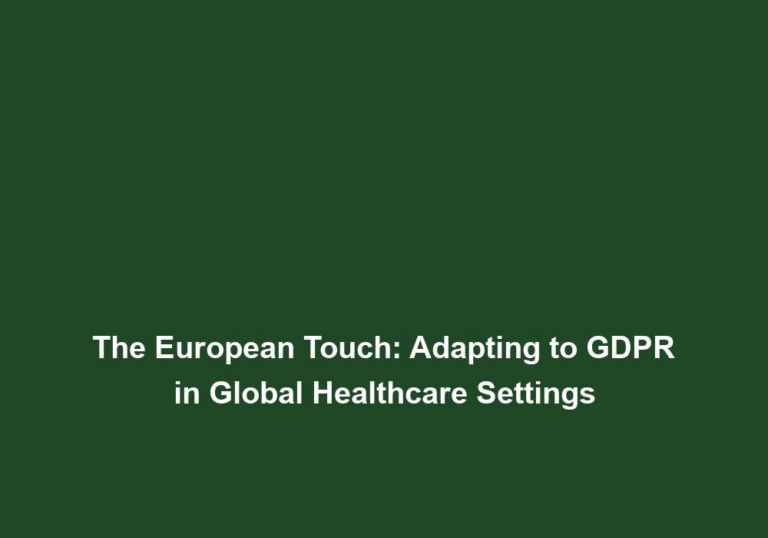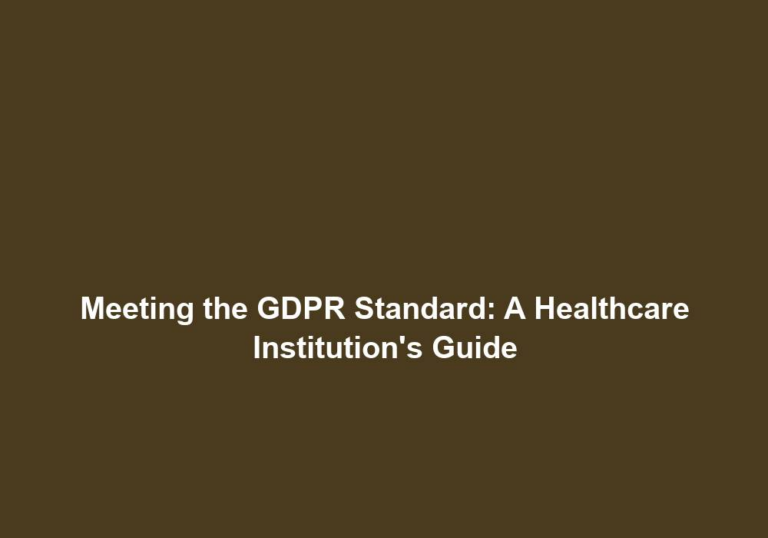GDPR in Healthcare: Best Practices for Patient Data Protection
In today’s digital age, healthcare organizations are increasingly reliant on technology to store and process patient data. With the implementation of the General Data Protection Regulation (GDPR), it is crucial for healthcare providers to ensure the security and confidentiality of patient information. This article will delve into best practices for protecting patient data in compliance with GDPR guidelines.
Understanding GDPR and Its Impact on Healthcare
The GDPR is a comprehensive data protection law that came into effect on May 25, 2018, aiming to strengthen data protection and privacy rights for individuals within the European Union. The regulation applies to any organization that processes the personal data of EU citizens, regardless of its location. Consequently, healthcare providers, even outside the EU, must comply with GDPR if they handle patient data from EU residents.
Data Mapping and Audit
To comply with GDPR, healthcare organizations should start by conducting a thorough data mapping exercise. This exercise involves identifying all the personal data your organization processes, including patient names, contact details, medical history, and any other identifiable information. By mapping out the data, you can gain a clear understanding of what information you have, how it is processed, and where it is stored. Additionally, performing regular audits can help ensure data accuracy and update any necessary information.
Lawful Basis for Processing
Under the GDPR, healthcare organizations must implement appropriate lawful bases for processing patient data. While consent is one such basis, it is essential to be aware that the GDPR has introduced stricter requirements for obtaining and managing consent. Healthcare providers should ensure that valid consent has been obtained from patients and maintain clear records of consent. It is also crucial to understand the other lawful bases for processing, such as the necessity of processing for the performance of a contract or compliance with a legal obligation.
Data Minimization
Adopting a data minimization approach is essential for healthcare organizations to minimize the risk of data breaches and maintain compliance with GDPR principles. Collecting only the necessary personal data required for patient care is key. Avoid excessive data collection or retention practices that may increase the risk of unauthorized access or disclosure. By minimizing the amount of data collected and stored, healthcare providers can reduce the potential impact of a data breach and enhance data protection.
Security Measures
Implementing robust security measures is vital to protect patient data from unauthorized access, disclosure, alteration, or destruction. Healthcare organizations should consider employing encryption, firewalls, and secure servers to safeguard sensitive information. Regularly updating software and conducting vulnerability assessments can help identify and mitigate potential security risks. It is also important to establish access controls and user authentication mechanisms to ensure that only authorized personnel have access to patient data.
Ensuring Patient Rights and Transparency
GDPR highlights the importance of providing patients with control and transparency over their personal data. Healthcare providers must ensure that patients can exercise their rights effectively. Here are some best practices to consider:
Privacy Notices
To comply with GDPR, healthcare organizations should clearly communicate their data collection, processing, and storage practices to patients through privacy notices. These notices should be concise, transparent, and easily accessible. Include information on the lawful basis for processing, data retention periods, and individuals’ rights under GDPR. By providing transparent information, healthcare providers can establish trust with patients and demonstrate their commitment to data protection.
Individual Rights
Familiarize yourself with individuals’ rights under GDPR, such as the right to access, rectification, erasure, and data portability. Healthcare organizations should establish procedures and systems to handle such requests effectively and within the required time frames. This may involve implementing secure portals or mechanisms for individuals to access and manage their personal data. Additionally, healthcare providers should have processes in place to verify the identity of individuals making data-related requests.
Data Breach Response
Developing a clear incident response plan is essential for healthcare organizations to effectively manage and respond to any data breaches. Rapid identification, containment, and notification to relevant authorities and affected individuals are crucial in mitigating the consequences of a breach. Healthcare providers should establish a dedicated team responsible for handling data breaches and ensure that staff members are trained on the proper protocols to follow in the event of a breach. Regular testing and simulation exercises can also help identify any vulnerabilities in the response plan and improve preparedness.
Training and Awareness
Proper training and awareness among healthcare staff are paramount to ensure compliance with GDPR guidelines. Consider the following recommendations:
Staff Education
Healthcare organizations should provide comprehensive training programs to educate employees on GDPR principles, patient data protection, and the consequences of non-compliance. This training should cover topics such as data handling, consent management, and incident reporting. By equipping staff members with the necessary knowledge and skills, healthcare providers can foster a culture of data protection and ensure that all employees understand their responsibilities in safeguarding patient data.
Data Protection Officer (DPO)
Designating a Data Protection Officer (DPO) responsible for overseeing GDPR compliance within your organization is a recommended best practice. The DPO should possess expert knowledge of data protection laws and serve as the point of contact for data protection-related concerns. They can provide guidance and support to staff members, conduct privacy impact assessments, and ensure that appropriate measures are in place to protect patient data.
Regular Training Refreshers
Healthcare organizations should conduct regular refresher courses and workshops to keep employees up to date with evolving data protection practices, emerging threats, and any changes in GDPR regulations. These sessions can provide an opportunity to address any questions or concerns staff members may have and reinforce the importance of data protection. By staying informed and updated, healthcare providers can adapt their practices to align with the latest requirements and enhance overall compliance.
International Data Transfers
If your healthcare organization transfers patient data outside the EU, it is crucial to follow specific GDPR regulations related to international data transfers:
Data Transfer Agreements
Ensure that any international data transfers adhere to GDPR requirements. Implement appropriate safeguards such as Standard Contractual Clauses (SCCs) or Binding Corporate Rules (BCRs) to ensure an adequate level of data protection. These agreements should be in place with any third-party organizations or entities that receive patient data from your healthcare organization. By establishing clear agreements, healthcare providers can ensure that patient data is protected even when transferred across borders.
Third-Party Vendors
If you share patient data with third-party vendors or processors, undertake thorough due diligence to ensure they comply with GDPR. Before engaging in any data sharing activities, healthcare organizations should assess the security measures and data protection practices of these vendors. Establish appropriate contracts and data processing agreements, outlining the responsibilities and obligations of both parties. Regular monitoring and audits can help ensure ongoing compliance and maintain the security of patient data.
Conclusion
The GDPR has significantly impacted the way healthcare organizations handle patient data. By implementing best practices for patient data protection, healthcare providers can ensure compliance with GDPR regulations while maintaining the security and confidentiality of patient information. By prioritizing data security, transparency, and staff education, healthcare organizations can build trust with patients and protect their most sensitive information effectively. Remember, GDPR compliance is an ongoing process that requires regular assessment, adaptation, and continuous improvement to keep up with evolving data protection practices and legal requirements.







